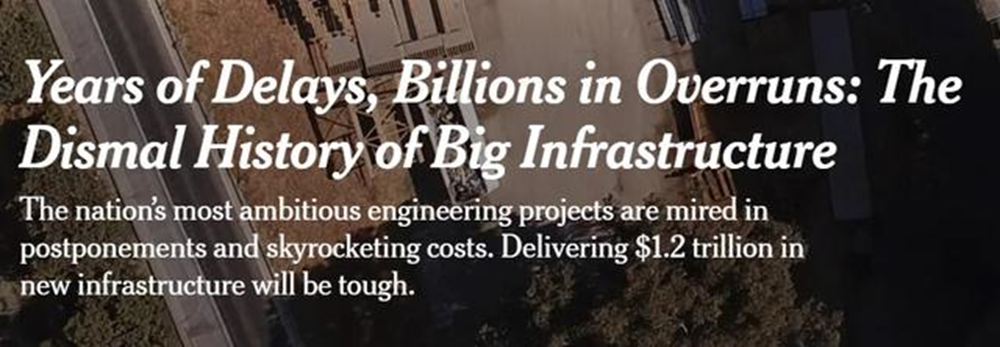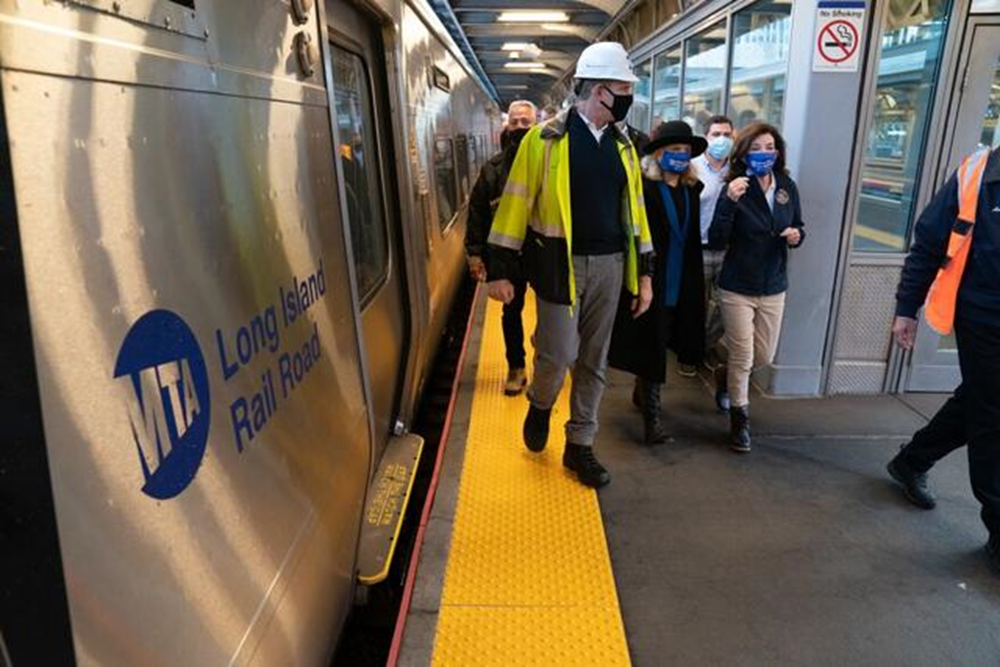Is USD 1.2 trillion enough to revitalize America's infrastructure?
No one can be optimistic about the above question if they look back at the major infrastructure projects of the United States in the past decades. On November 28, the New York Times recalled the "history of modern infrastructure in the United States" and found that the United States failed to complete any of its major infrastructure projects as planned in the past decade due to political partisanship, engineering difficulties, design changes and other factors. These projects ended up with budget overruns.

Screenshot from The New York Times
For example, as Honolulu, Hawaii's capital, sprawled into new suburbs west of Pearl Harbor over the recent years, city planners proposed an ambitious rail transit line that would sweep riders 32 km into downtown. The USD 4 billion estimate in 2006 was hardly cheap, amounting to USD 125 million per kilometer.
Concerns over Native Hawaiian burial grounds stalled early construction, then problems with welding and cracks in the tracks appeared. Earlier this year, engineers realized that in some sections, the wheels were a half-inch narrower than the rails.
With all these incidents. the launch date slipped forward and the cost estimates crept upward — at latest count, USD 11.4 billion, up from USD 4 billion, with a target completion date of 2031.
According to The New York Times, Honolulu’s tribulations are far from a lone cautionary tale. To the contrary, they signal the kind of cost overruns, engineering challenges and political obstacles that have made it all but impossible to complete a major, multibillion-dollar infrastructure project in the United States on budget and on schedule over the past decade.
As the nation sets out on a national spending spree fueled by the USD 1.2 trillion infrastructure bill signed by President Joe Biden this month, the job ahead carries enormous risks that the projects will face the same kind of cost, schedule and technical problems that have hobbled ambitious efforts from New York to Seattle, delaying benefits to the public and driving up the price tag that taxpayers ultimately will bear.
American cities and states were long renowned for some of the greatest bridges, water systems and freeways in the world, but challenges have grown more potent. Agencies have less internal technical talent. Legal challenges have grown stronger under state and federal environmental laws. And the spending on infrastructure as part of the economy has shrunk, while local agencies are also less experienced in modern infrastructural practices.
Biden’s USD 1.2 trillion package has bold goals, directing the majority of USD 500 billion to highways, USD 39 billion to urban transit, USD 65 billion to broadband projects and USD 73 billion to electrical grids, among other items. The nation’s busiest passenger rail line, Amtrak’s Boston-to-Washington corridor, would get the biggest slice of a USD 66 billion rail package.
The New York Times said the infrastructure spending plan is unlikely to rescue some existing infrastructure projects that are bogged down with problems. Even with the new infusion of money, analysts say it will be tough to ramp up infrastructure progress as swiftly as envisioned in the current timetable.
The construction industry is facing sharply growing costs for steel products, up by 142% in the last 12 months, and other key materials. Shortages of skilled labor are worsening, exacerbated by COVID-induced unemployment.
In some cases, U.S. construction costs are higher than those in Western European and Asian countries, said Ethan Elkind, a professor at the University of California, Berkeley. “It is a lot harder to build projects here, and we are not as skilled at doing it,” he said.
"It's like digging a hole that gets bigger and bigger until you have no choice but to fill it with money."
The New York Times also cites another example. When California voters approved a bond in 2008 for a high-speed rail system from Los Angeles to San Francisco, the project was supposed to cost USD 33 billion and be completed by 2020. This year, the project is far from complete. The job is now projected to finish in 2033 for USD 100 billion, and there is an USD 80 billion funding gap.
The ambitious project, the nation’s most serious effort to build a full-scale bullet train, has encountered serious delays because of land acquisition issues, environmental litigation, permit setbacks, employee turnover and significant design changes.
Not only California's railroads, but East Coast railroads are also suffering from similar problems. Lengthy delays have also affected New York’s East Side Access extension of the Long Island Rail Road, which is supposed to cut up to 40 minutes off commuter time on the last segment, from Queens to Grand Central Terminal, with up to 24 trains per hour at peak times.
Conceived more than a half century ago, with a construction contract awarded in 2006, that project was supposed to be completed by 2011. Early estimates put the cost at USD 2.2 billion, then USD 4.3 billion in 2006 and USD 6.4 billion in 2008. The Metropolitan Transportation Authority now envisions completion in December 2022 at a cost of USD 11.1 billion. Design changes, underground tunneling problems and coordination with other agencies were some of the factors in the delays and cost increases.

Kathy Hochul, New York's new Governor, takes a test run on the Long Island Rail Road earlier this month. Image from the Governor's office
Not only public transport projects, but also other infrastructure projects are facing many difficulties.
The Hanford nuclear power project in Washington State is one of the nation's most important environmental infrastructure projects, and perhaps the most technically difficult one. The project has been underway in Central Washington State for decades at the former Hanford nuclear weapons site. Since 2013, major construction has been stopped at two partially built plants to treat and vitrify 56 million gallons of radioactive sludge.
When an independent review in 2015 found 362 significant design problems, including shockproof design and the possibility that the chemical processes to separate high-level radioactive materials could cause explosive hydrogen gas to form, the Energy Department announced a 17-year delay and estimated the system would become fully operational in 2036.
The delays have pushed the Energy Department to adopt an alternative that would start treating low-level waste by the end of 2023, Washington State officials said. The last cost estimate for the plant was USD 17 billion, up from USD 12.3 billion in 2013 and about USD 4 billion 20 years ago.
The setbacks that resulted in Hawaiian rail delays — archaeological surveys, labor costs, utility relocations and land acquisition — are the kind of challenges that plague nearly all major infrastructure projects; the common mistake is in not planning and budgeting for them, said Joseph Schofer, a Northwestern University civil engineer and originator of the “Infrastructure Show” podcast.
“You can’t say these were an accident,” Schofer said of most cost overruns. “We could do better. We haven’t gotten honest estimates in a lot of cases.”
Schofer said many projects are justified by estimating that future benefits will exceed costs, but when the costs go up astronomically, no one recalculates the ratio.
Willie Brown, the former mayor of San Francisco, candidly admits how the "political game" of infrastructure operates. In 2013, he dismissed cost overruns on a transportation hub intended for the bullet train in a guest newspaper column. “In the world of civic projects, the first budget is really just a down payment. If people knew the real cost from the start, nothing would ever be approved,” Brown stated.
Brown acknowledged that the purpose of the first budget was to "get the project off the ground," like "digging a hole and make it so big there’s no alternative to coming up with the money to fill it in."
